What Do You Use To Clean Thermal Paste
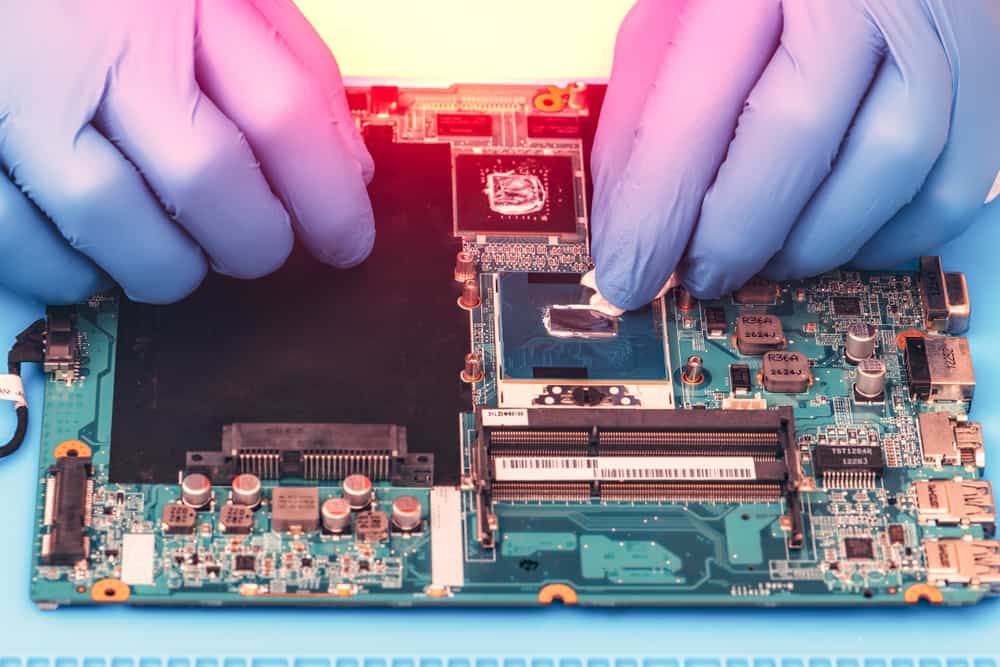
If you've experienced a heating trouble in your PC, you may want to consider replacing the CPU's thermal paste as one of your options for correcting this.
You beginning need to clean off the old, probably stale-out, thermal paste.
Since the CPU is a very sensitive computer component, you lot need to be careful while cleaning thermal paste.
This article offers a step-by-step guide to make clean old thermal paste off the CPU.
How To Prepare For Removing Thermal Paste
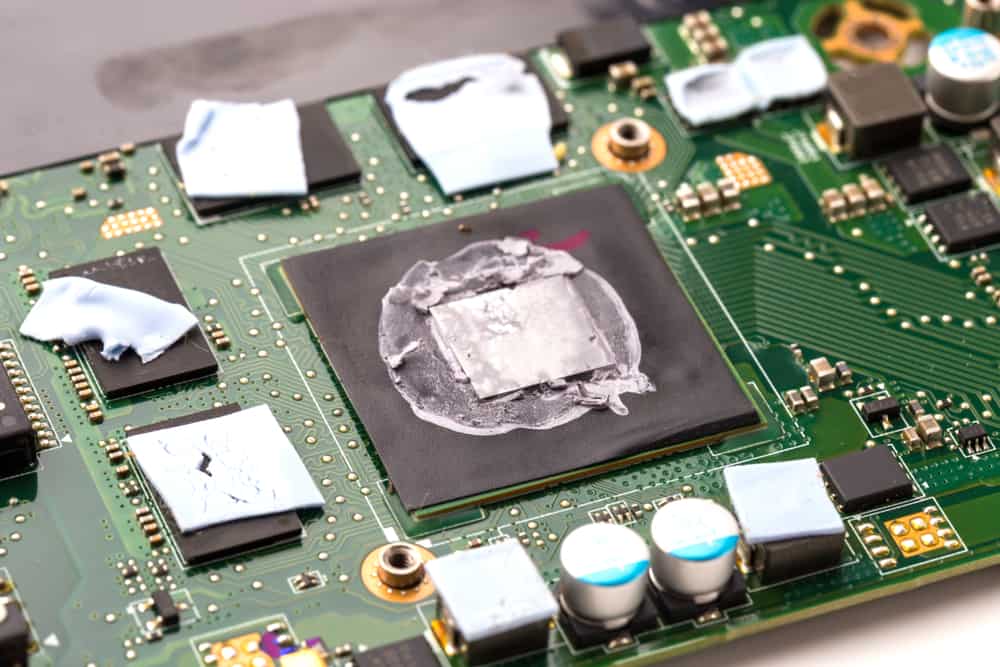
The actual process of removing thermal paste off the CPU doesn't accept that long.
However, the preparation procedure is much more than of import since you need to stay safe.
1. Things You lot Need

- Microfiber cloth, Q-tips, or coffee filters
- Isopropyl booze or thermal paste cleaner
- Plastic Spudger
- Anti-static bracelets
- Latex gloves
2. Prepare Your Workspace

Preparing your figurer and workspace is different for laptop and desktop computers.
For a desktop computer:
- Turn off your PC. If your computer is on, it'due south improve to close it down using the start bill of fare on the screen instead of the ability button. That'southward because information technology may put your system into sleep mode.
- Unplug all the cables and cords. If you have any other devices connected to your reckoner, including printers or HDMI cables, disconnect all of them.
For a laptop computer:
Preparing your laptop figurer can exist more than challenging as you need to open the back of the device.
Over again, y'all should commencement by shutting it down and unplugging all the cords and devices, including the charger.
So flip the device over and separate the battery compartment past sliding the release latch.
Now the bombardment is released, and y'all can remove information technology.
Although you've unplugged the ability cord, the motherboard may still take some electric accuse.
Therefore, hold the power push button for at least 10 seconds to let the charge fully dissipate.
three. Disassemble The PC

To dismantle your laptop, loosen the screws on the laptop's bottom (depending on the model and make, the number of screws will be different).
At present flip the laptop back upwardly and slide the keyboard tabs upward to remove the keyboard.
Later on removing the keyboard, locate and remove the fan and the heat sink.
Since every laptop volition have different construction details, information technology's important to consult the manufacturer'due south instructions and follow the steps carefully to dismantle the laptop.
Before proceeding to the next steps, you need to consider some safety precautions.
First, make certain your workspace is clean and dust-free, as dust can enter your organization's components and cause damage.
You may too want to wear latex gloves to foreclose your skin oils from touching and damaging the components.
It'southward too a good thought to wearable an anti-static bracelet to ground yourself to the computer chassis and go on your fingers from producing static discharge.
Now that everything is ready, you tin can access the heatsink and the CPU.
Depending on your computer model, you may need to go through different processes.
Use the owner'southward manual or search online to see how y'all tin remove the components.
4. Clean The Components

After removing the heatsink, use a can of compressed air or a small castor with fine bristles to make clean any dust from the vents.
If you use compressed air, keep the nozzle at a 40-degree angle from the computer parts.
Plus, direct the air abroad from other components so that the grit doesn't end upward on other parts.
5. Clean The Thermal Paste

At present that you have access to the heatsink, you lot can clean off the onetime thermal paste.
Gently remove the wires and lift the heatsink to split up information technology from the CPU.
If it'due south stuck to the motherboard, gently wiggle it back and along until it'due south loosened.
After separating the heatsink, use a castor or compressed air to remove any dust built up inside the vents.
You could use a spudger to scrape off some of the one-time paste, simply you demand to be careful since you may scratch the components.
You could also rub off some layers of the paste using a dry out paper towel or cloth.
Endeavor to remove equally many big chunks every bit possible.
Withal, if you lot call up you lot tin can't practice it safely, yous tin skip this stage.
Using a spudger doesn't guarantee getting rid of the paste entirely.
Whether y'all utilise the spudger or not, you lot volition need a gentle solvent such equally rubbing alcohol (isopropyl).
Now, have some Q-tips, coffee filters, or lint-free cloths such as microfiber cloths and wet them with rubbing alcohol.
Rub the cloth or Q-tip advisedly on the onetime paste until it comes off entirely.
Isopropyl or other cleaners specifically designed to remove thermal paste tin moisten and loosen the paste and remove it scratch-gratuitous.
Repeat the process using clean cloths and employ alcohol as many times as needed until there'due south no trace of the old material.
Do the same with the CPU and the heatsink.
When you wipe off the erstwhile paste, be conscientious not to brush it off, making it cease up in other parts of the processor.
Carefully rub it off using upward motions with the cloth.
Now audit all parts of the processor for any traces of erstwhile paste.
If you applied the one-time paste yourself, information technology may have ended up elsewhere and dried to other components.
If the paste has gotten into hard-to-reach places, use thin Q-tips and rub them gently inside any gaps to avert harm.
Afterward cleaning and wiping all components, y'all'll have a mirror-similar surface on the CPU and the heatsink, just like when you bought information technology.
If yous feel the thermal paste has leaked nether the CPU, you can safely open its latch and clean the sides of the processor.
To make sure there are no remaining particles of lint or dust, you tin can utilise compressed air.
Any tiny dust particle may cause the heatsink non to lay completely flat on the CPU, reducing the cooling procedure'southward efficiency.
Condom Tips

Here are some tips to consider when cleaning thermal paste off of the CPU.
1. Lint-free Textile

The fabric you employ to clean the old thermal paste needs to be lint-complimentary since lint tin inhibit heat transfer.
That means you can't utilize toilet newspaper, facial tissue, or regular cleaning cloths.
The simply condom options are microfiber cloth or coffee filters.
Since thermal paste ruins the fabric, it has to be dispensable or something yous don't plan on using subsequently.
You could likewise use an old T-shirt equally a lint-free option.
2. Solvents

Isopropyl is the all-time option as a solvent fluid, merely you still need to be careful.
There are different purity percentages of rubbing alcohol on the marketplace, such as 70% or 90%.
The all-time purity percentage is 99% because others may comprise additives such equally color or oils.
That means the fluid doesn't evaporate fully, and you'll have some residue left on the CPU.
Other options such as boom polish remover, vodka, tequila, acetone, or other cleaners are a definite no-no.
Some users have reported using these materials successfully with no residue, but you need to exist careful equally they'll leave balance and damage the components.
You could also use cleaners specifically designed for removing thermal paste.
If you don't accept admission to any of these, booze rubs are also a good choice if you lot're sure they don't contain any added oil.
One of the near important things to consider is to steer clear of water.
When you utilize water, you tin never be sure if it's completely dry or not because it doesn't evaporate as fast as alcohol.
Plus, information technology can't dissolve the thermal paste completely, and you may impairment your CPU past rubbing besides much.
Too, since alcohol isn't conductive, you don't need to worry about damaging your components later on you reassemble the parts.
How To Make clean Thermal Paste Off CPU Sockets And Pins

Sometimes you get thermal paste within the CPU's pins and sockets, especially if you accept practical the thermal paste yourself or accidentally get the thermal paste inside the pins after removing information technology from the CPU.
The kickoff thing to do is look at your socket type since at that place are two types of CPU sockets depending on the brand.
- PGA sockets, used in AMD CPUs, have holes in which pins are inserted, and the pins are on the processor. That makes cleaning the thermal paste more difficult because you may bend the pins if you're not careful.
- LGA sockets, used in Intel CPUs, have slots instead of holes and the pins aren't on the processor but on the motherboard.
Since the LGA pins are at a 45-degree bending, you lot should make clean them in the verbal management, or you'll bend them.
Plus, the pins will grip on the cloth, making lint stick to the tips.
You lot can apply a magnifying drinking glass to conspicuously see how the pins are pointing out.
If y'all tin can't see the direction of the pins, you can try this method:
Put the CPU socket directly under a brilliant source of low-cal.
Place a magnifying glass at a 45-degree angle to the CPU socket and look at the pins' shadows through the magnifying glass.
The direction of the shadows is the direction in which yous should wipe.
Clean the pins using a dry cloth or Q-tip from the bottom to the tip.
Then apply the isopropyl alcohol or the thermal paste cleaner straight on the thermal paste, covering all the holes and gaps between the pins.
Wait for five minutes for the thermal cleaner to pull it apart.
Brush in a directly line, from the bottom to the tip, using a microfiber cloth.
If you see paste building upwardly on the cloth, change it to ensure a tidy cleanup.
Since the PGA socket has holes, y'all demand to make clean each hole gently using a fine toothpick.
If the alcohol or cleaning fluid has spread out, you should clean information technology thoroughly with gentle mopping actions.
For an LGA socket, y'all can put the material on the pins to get the excess fluid absorbed.
Since it's not possible to make clean the thermal paste completely, don't exert too much pressure because it's safer to leave some thermal paste backside than to adventure damaging the fragile pins.
Now, you need to give the motherboard plenty fourth dimension to let it dry.
The sockets and holes demand at least 24 hours to dry completely.
Utilise a magnifying drinking glass to inspect all holes, and if they're still wet, look for some other 24 hours.
At present, you lot tin use a surface purifier to make certain everything is spotless.
Moisture Q-tips with a few drops of the surface purifier and motility it in the direction of the pins.
For a PGA socket, you lot tin can gently move the Q-tip within the holes.
Remove the excess surface purifier by dabbing a microfiber textile on the holes, then let it dry out for 24 hours.
Exercise Yous Need To Apply A New Thermal Paste?
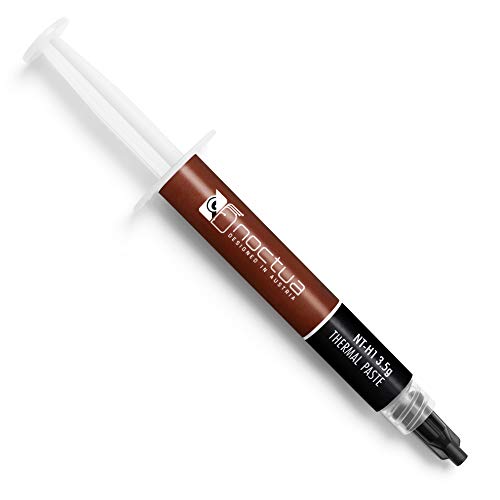
Thermal paste is an essential part of your computer that helps conduct the heat between the CPU and the heatsink, a rut distributor.
Although the pinnacle of the CPU and the bottom of the heatsink are in close contact, information technology's non plenty for a smooth heat transfer.
That'south because the surfaces of these 2 components aren't smooth and accept microscopic gorges and valleys.
The thermal paste fills all these pores and creates perfect contact between the two surfaces.
However, the layer has to be as thin as possible because you only need it every bit a smoothing agent.
If it's thick, it will block the contact between the CPU and the heatsink.
Reapply Thermal Paste On CPU
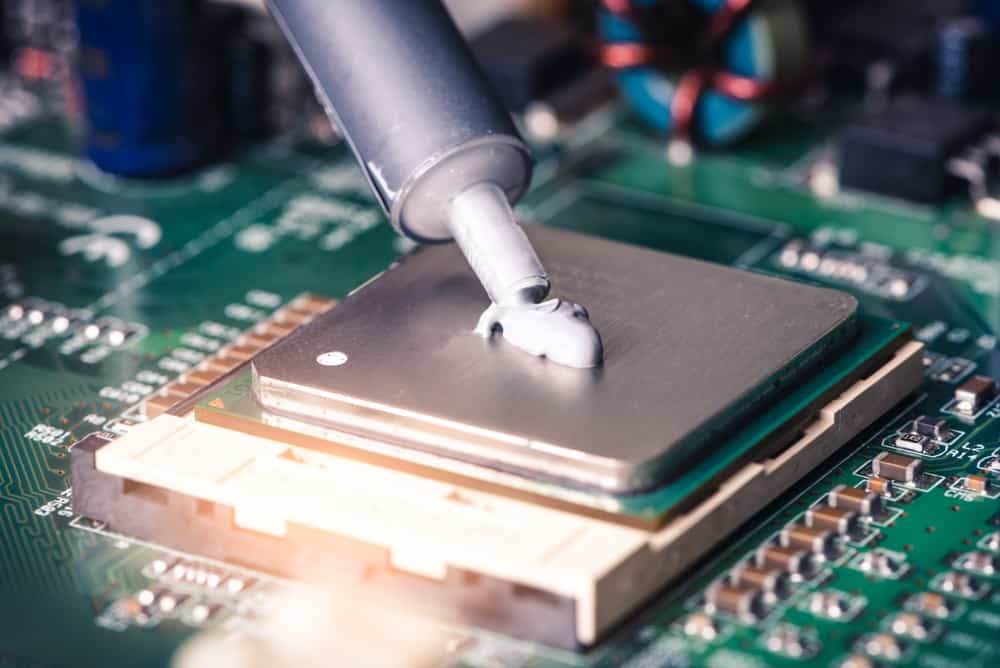
When y'all remove the thermal paste, you lot need to reapply it to make sure your system's cooling remains functional.
Afterward cleaning the old thermal paste, requite the components plenty time to dry completely and prepare the surface for the awarding of the new thermal paste.
Depending on the type of CPU, there are different recommended methods to employ the thermal paste.
In that location's the dot method, cantankerous line, spread method, vertical line, or horizontal line.
The dot method involves putting a dot of thermal paste on the core and putting the oestrus sink on it.
You don't demand to spread it as the pressure applied by the heatsink will spread the paste evenly.
Don't use also much paste, or it will spill out onto other surfaces.
The cross method means drawing a line from i corner of the core to the other and repeating for the other ii corners.
There'southward as well the spread method, which involves putting a tiny dab of paste on the CPU.
And so you wear safety gloves and spread the paste all over the surface of the core using your index finger.
Then you gently place the heatsink on the CPU.
The cardinal signal in all of these methods is not to apply any pressure when you place the heatsink.
You besides don't need to use the paste to the heatsink as you only demand a minimal amount of paste.
Never movement the heatsink after putting it on the core because, otherwise, you won't have an even distribution of the paste, and you need to clean and reapply it.
Applying too little thermal paste volition make the cooling process ineffective because it tin't conduct heat properly.
Afterward reapplying thermal paste, you can reassemble the parts and test your organisation to encounter if it works.
If you don't know how to do it, you tin utilise your owner's manual or watch video tutorials online.
Removing Thermal Paste From GPU
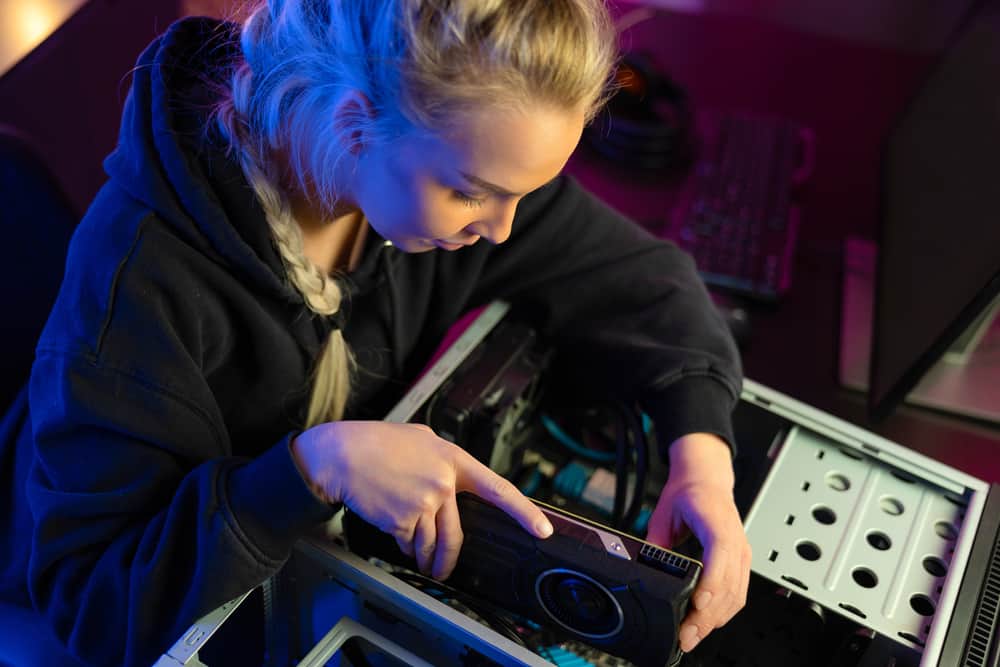
GPU is another main component of PCs that needs cooling, and thus, applying thermal paste.
The process of removing sometime thermal paste is similar to that of the CPU.
You need to detach the GPU carefully and use the same materials to make clean it.
The only trouble is that disassembling the GPU volition void your warranty, then practice it only if you're okay with that.
Turn off your PC and remove whatsoever ability cable or string attached to it.
To disassemble the GPU, loosen the screws that connect the GPU and the heatsink.
Disconnect the cable that connects the fan to the card and detach the GPU cover.
Disconnect the heatsink from the GPU and remove it with gentle movements.
To remove the heatsink, you need to disengage the screws on the dorsum of the card, merely some models have plastic clips that you can release using a pair of pliers.
Use compressed air or a modest castor to clean the GPU of dust.
As with the CPU, use a lint-costless cloth and alcohol to remove the sometime thermal paste from the GPU and the heatsink.
Then, apply a few drops of surface purifier on a piece of clean fabric and rub it on the GPU to make sure it'south completely make clean.
Source: https://www.thetechwire.com/how-to-clean-thermal-paste-off-cpu/
Posted by: lugobeivieve.blogspot.com


0 Response to "What Do You Use To Clean Thermal Paste"
Post a Comment